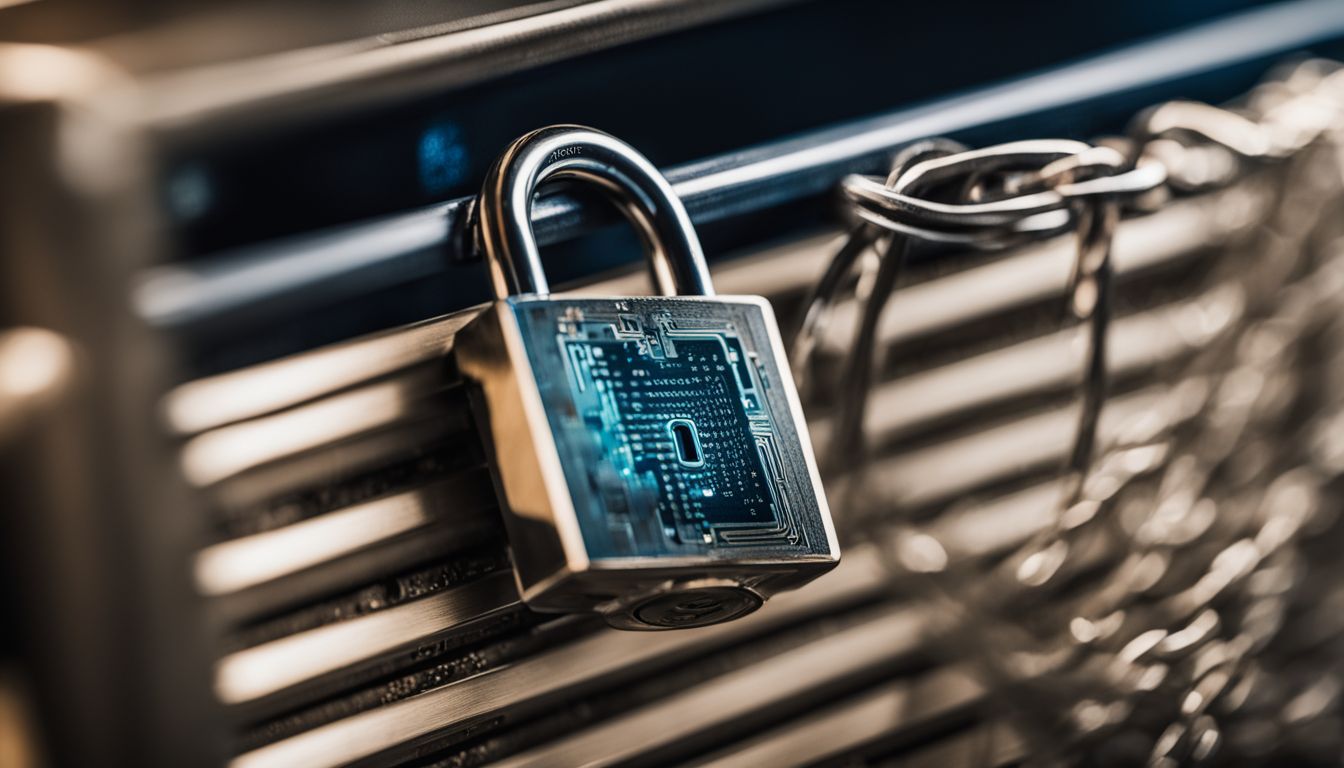As a business owner using blockchain technology, you might worry about the potential security vulnerabilities in your system. Did you know that several companies have lost millions of dollars due to unaddressed weaknesses in their blockchain networks? This article provides a comprehensive guide on why and how to conduct a Blockchain Security Audit that will protect your project from cyber threats and data breaches.
Let’s delve deeper into making your blockchain applications secure and hack-proof!
Key Takeaways
- Conducting a blockchain security audit is crucial for ensuring enhanced security, avoiding cross – chain bridge attacks, preventing compromised private keys, and addressing potential vulnerabilities within the blockchain system.
- Enhanced Security: Blockchain security audits significantly enhance the security of your blockchain architecture by identifying and plugging in vulnerabilities in smart contracts.
- Avoiding Cross-Chain Bridge Attacks: Thorough security audits help identify and address potential vulnerabilities in cross-chain bridges to prevent unauthorized access or manipulation of data and transactions.
- Preventing Compromised Private Keys: By implementing strict security measures like secure wallets and two-factor authentication, users can reduce the risk of their private keys being compromised.
Understanding Blockchain Security Audits

A Blockchain Security Audit is a comprehensive assessment of the security measures and vulnerabilities in a blockchain system. It is crucial to conduct such audits to ensure the integrity and safety of blockchain networks and applications.
Definition of a Blockchain Security Audit
A Blockchain Security Audit is a rigorous examination conducted to detect any vulnerabilities in a blockchain system or application. This process scrutinizes the structure, workflow, and code of your blockchain project to identify possible loopholes that might be exploited by attackers.
The audit particularly focuses on smart contracts due to their high susceptibility to hacking attempts attributed to developmental flaws. Crucial for industries like banking, healthcare, finance and gaming among others; the objective of such an audit is not only to protect these decentralized systems from cyber threats but also ensure robust security mechanisms are in place for seamless operation.
The need for a Security Audit in Blockchain
Blockchain systems, despite their robust structure and high-tech design, remain susceptible to cyber threats. This vulnerability stems from the fact that smart contracts on blockchain networks can be hacked due to existing or potential security loopholes.
As a result, thorough blockchain security audits become essential in these scenarios as they help identify risks and provide remediation for them before exploitation occurs. Highly publicized instances of cryptocurrency theft like those experienced by trading platforms such as Coincheck Inc.
and 2gether underline the significance of such audits. By conducting regular blockchain code audit reviews, developers not only ensure the immunity of their applications against attempts at unauthorized access but also protect users’ valuable data from being misused or manipulated using sophisticated cyber attack techniques.
Without implementing an effective blockchain security assessment program, both businesses and users could suffer significant financial losses resulting from compromised private keys or successful cross-chain bridge attacks utilizing existing flaws within the system’s architecture.
The Importance of Conducting a Blockchain Security Audit

Conducting a blockchain security audit is crucial for ensuring enhanced security, avoiding cross-chain bridge attacks, preventing compromised private keys, and addressing potential vulnerabilities within the blockchain system.
Enhanced Security
Blockchain security audits significantly enhance the security of your blockchain architecture. They scrutinize and identify vulnerabilities in smart contracts, critical components that are frequently attacked by hackers.
Identifying these weaknesses ahead of time allows developers to plug in security gaps and fortify the overall system. Regularly conducted security audits keep your project safe from emerging cyber threats while improving the reliability and credibility of your blockchain applications among users and investors alike.
With a professionally conducted audit, you can detect development flaws earlier which mitigates potential losses caused by data breaches or thefts – securing both your project’s viability and reputation.
Avoiding Cross-Chain Bridge Attacks
Conducting a blockchain security audit is essential to avoid cross-chain bridge attacks. These attacks pose a significant threat in the blockchain industry and can result in the loss of valuable assets.
By conducting a thorough security audit, potential vulnerabilities in the cross-chain bridge can be identified and addressed before they are exploited by attackers. This ensures that the bridge remains secure and trustworthy, preventing any unauthorized access or manipulation of data and transactions.
A reputable company like Astra Security offers professional blockchain security audits, including comprehensive testing and vulnerability scanning to ensure the safety of your project.
Preventing Compromised Private Keys
Compromised private keys are a significant security risk in blockchain systems. These keys are essential for accessing and managing digital assets, and if they fall into the wrong hands, it can lead to unauthorized access and theft.
To prevent compromised private keys, strict security measures need to be implemented. This includes using secure wallets or hardware devices to store private keys offline, enabling two-factor authentication for added protection, and regularly updating passwords.
By taking these precautions, users can significantly reduce the risk of their private keys being compromised and ensure the safety of their blockchain assets.
Addressing Potential Vulnerabilities
Blockchain systems are not immune to vulnerabilities, making it essential to address potential weaknesses through security audits. These audits help identify and mitigate any loopholes or flaws in the system that can be exploited by cyber criminals.
By conducting a thorough assessment of the blockchain network, including its protocols, smart contract code, and overall architecture, potential vulnerabilities can be identified and addressed proactively.
This proactive approach reduces the risk of unauthorized access, data tampering, and other forms of cyber attacks that could potentially result in significant financial losses. Regular security audits play a crucial role in ensuring the integrity and reliability of blockchain-based applications and protecting them from potential threats.
Step-by-Step Process of Conducting a Blockchain Security Audit

Identify the components and data flows of the target system, assess potential security risks, conduct threat modeling and exploitation analysis, and remediate any identified threats.
Read on to learn how to ensure the security of your blockchain project.
Defining the goal of the target system
The goal of conducting a blockchain security audit is to protect against cyber threats and vulnerabilities. By defining the specific goals of the target system, auditors can determine the scope and objectives of their assessment.
This involves understanding the purpose and functionality of the blockchain network, including its applications, smart contracts, and data flows. Defining these goals helps auditors identify potential risks and vulnerabilities that may exist within the system.
It also allows them to focus on specific areas that require attention in order to enhance security measures and ensure the integrity of the blockchain ecosystem. With clear goals in place, auditors can conduct a thorough evaluation of the target system’s security framework and take necessary steps to mitigate any identified risks or weaknesses.
Identifying components and data flows of the target system
In a blockchain security audit, one of the important steps is to identify the components and data flows of the target system. This involves understanding the architecture of the system and how different elements interact with each other.
By examining these components and data flows, auditors can assess potential vulnerabilities and security risks within the blockchain system. It also helps them analyze how information is transmitted and processed throughout the network.
Identifying these components and data flows is crucial for gaining an overall view of the system’s security posture and ensuring its integrity.
Identifying potential security risks
Conducting a blockchain security audit involves a crucial step: identifying potential security risks. This is essential to ensure the overall safety and integrity of the blockchain system.
By thoroughly examining the system, its components, and data flows, cybersecurity professionals can identify vulnerabilities that could be exploited by hackers or malicious actors.
This process helps in understanding where the weaknesses lie so that appropriate measures can be taken to address them effectively. It also allows for proactive mitigation strategies to be implemented, reducing the risk of potential attacks and ensuring the secure functioning of the blockchain network.
Threat modeling and exploitation analysis
Threat modeling and exploitation analysis play a crucial role in conducting a thorough blockchain security audit. By identifying potential security risks and vulnerabilities, these steps help ensure the overall system security.
Threat modeling helps pinpoint any weaknesses or flaws that could be exploited by hackers or cyber attackers, while exploitation analysis focuses on understanding how these vulnerabilities can be manipulated to compromise the system.
It is through this detailed examination that blockchain developers can then take necessary measures to patch these vulnerabilities and strengthen the security of their blockchain networks.
Remediation of identified threats
Identifying and addressing threats is a critical aspect of conducting a blockchain security audit. Once potential vulnerabilities are identified, the next step is remediation. This involves taking action to patch these vulnerabilities and ensure the overall security of the blockchain system.
By promptly addressing these threats, businesses can mitigate risks and prevent unauthorized access or data manipulation in their blockchain networks. Through exploitation analysis and thorough remediation measures, organizations can enhance the security posture of their blockchain systems, safeguarding them against cyber attacks and financial losses.
Regularly remediating identified threats is vital for maintaining the integrity and reliability of blockchain technology.
The Role of Automated Analysis in Simplifying the Audit Cost
Automated analysis plays a significant role in simplifying the audit cost associated with conducting a blockchain security audit. By utilizing automated tools, the process becomes more streamlined and efficient, ultimately reducing manual labor costs.
These tools can identify vulnerabilities and flaws in blockchain-based applications and smart contracts at a faster pace than manual inspections alone.
One of the key advantages of automated analysis is its ability to save time and resources, making audits more cost-effective. Instead of relying solely on human auditors to manually review code and conduct assessments, automated tools can perform these tasks quickly and accurately.
This not only speeds up the overall audit process but also allows for more comprehensive coverage.
Moreover, integrating automated analysis into the audit process improves the overall security and integrity of a blockchain project. These tools are designed to detect potential risks or weaknesses that may go unnoticed by human auditors.
By identifying these issues early on, developers can address them promptly before they pose a greater threat.
In conclusion, incorporating automated analysis into blockchain security audits offers several benefits such as reduced costs through streamlined processes, saving time and resources while improving overall project security.
It’s clear that automation is playing an increasingly vital role in simplifying the audit cost for organizations looking to secure their blockchain systems effectively.
Conclusion
Conducting a blockchain security audit is crucial for any project. It enhances security, prevents cross-chain bridge attacks, safeguards private keys from compromise, and addresses potential vulnerabilities.
By following a step-by-step process and utilizing automated analysis tools, you can ensure the integrity of your blockchain system. Don’t risk falling victim to cyber threats – prioritize the importance of conducting regular blockchain security audits for your project’s protection.
FAQs
1. Why is it important to conduct a blockchain security audit for your project?
Conducting a blockchain security audit is important to identify and mitigate vulnerabilities in your project, ensuring the safety of funds and data stored on the blockchain.
2. What does a blockchain security audit involve?
A blockchain security audit involves analyzing the code, architecture, and configuration of your project to assess potential risks and weaknesses that could be exploited by attackers.
3. Who should conduct a blockchain security audit?
It is recommended to hire experienced professionals or specialized companies with expertise in conducting blockchain security audits to ensure thorough evaluation and accurate identification of vulnerabilities.
4. How often should I conduct a blockchain security audit for my project?
The frequency of conducting a blockchain security audit depends on factors such as the complexity of your project, regulatory requirements, industry standards, and changes made after previous audits. It’s best to consult with experts for appropriate timing recommendations.